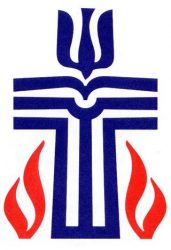
Window #1 Top 
Window #1 Bottom
Window #1 – TOP CREATION Genesis 1:1-27: The right hand extending downward is used as a symbol of the Creator God. The hand points to the creation: the sun and planets above the tree and ground and waters of the earth.
Window #1 – BOTTOM EXPULSION FROM THE GARDEN Genesis 3:22-24: Following the disobedience of the first man and woman and the entry of sin into creation, God drove them from the garden by an angel with a flaming sword. A serpent is at the base of the sword, symbol of temptation.

Window #2 Top 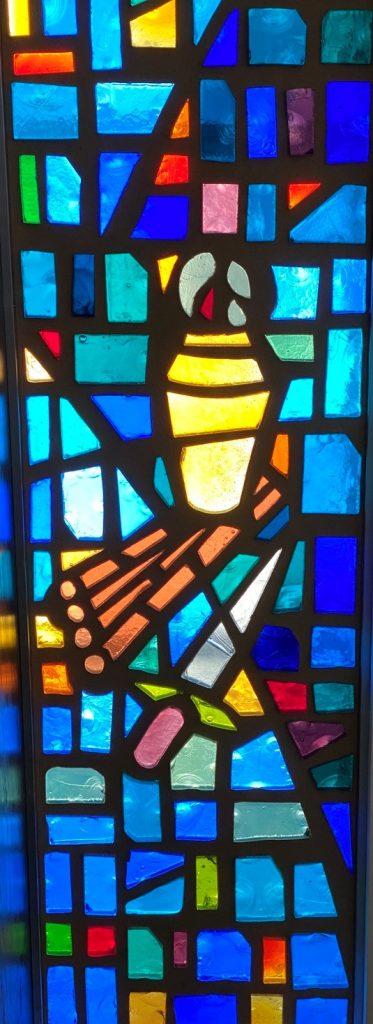
Window #2 Bottom
Window #2 – TOP THE FLOOD Genesis 7:1-5: Noah’s Ark is the symbol of the great flood. The presence of the rainbow symbolizes the promise of God for deliverance and protection in the covenant with Noah and the new covenant God made with the church.
Window #2 – BOTTOM ABRAHAM AND ISAAC Genesis 22:1-2, 9-13: A sacrificial knife, a brazier of coals, and a bundle of wood recall Abraham’s near sacrifice of his son Isaac.

Window #3 Top 
Window #3 Bottom
Window #3 – TOP THE CALL OF MOSES Exodus 3:1-15: A burning bush, yet not consumed, is the symbol of God’s call to Moses in the Sinai Desert to lead the Israelites from the land of bondage in Egypt to the Promised Land.
Window #3 – BOTTOM THE TEN COMMANDMENTS Exodus 20:1-17: Two tablets of stone symbolize the laws of God for humankind which were given to Moses on Mount Sinai during the time of the Exodus from Egypt. The first four describe the relationship between humans and God; the last six represent the relationships between people.
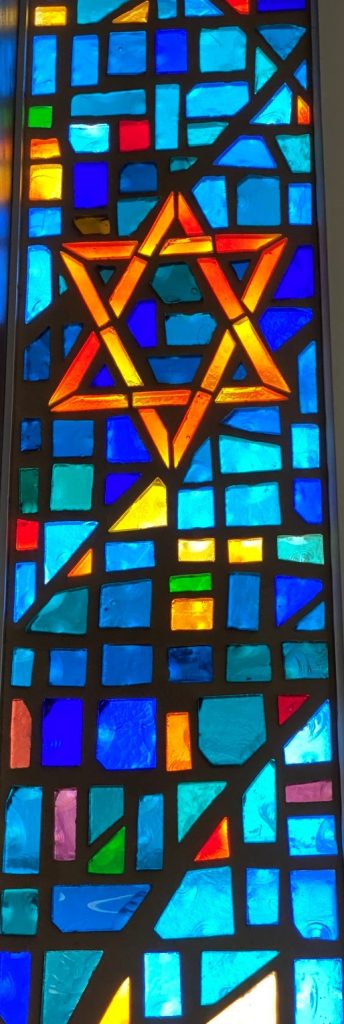
Window #4 Top 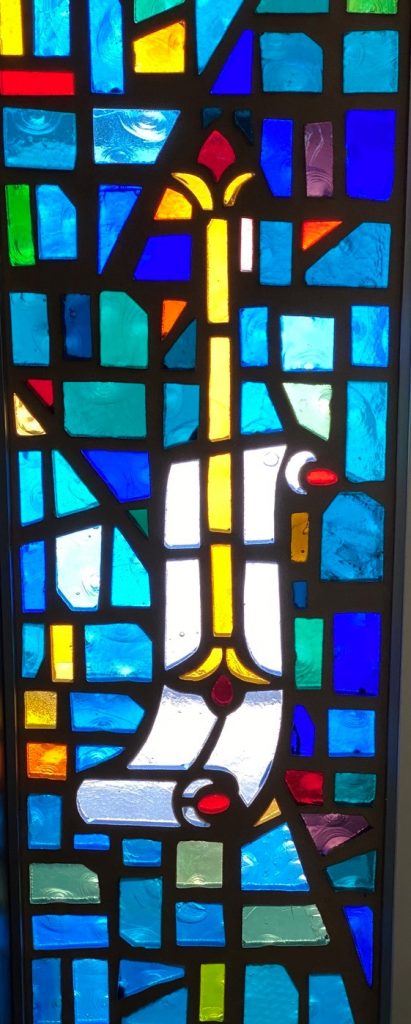
Window #4 Bottom
Window #4 – TOP DAVID: During the last two centuries the six-pointed star has become a distinct Jewish symbol. One motive was the desire to have a common Jewish identification similar to the Christian cross. Used by the Nazi’s during World War II as a badge of shame, it came to represent unity, hope, and survival among the Jewish people. Although sometimes denoted as the shape of the shield David carried into battle as King of Israel, there is no mention of the star in Scripture.
Window #4 – BOTTOM SOLOMON 1 Kings 3:7-13: The scepter is a rod held in the hands of kings as a symbol of authority. The scroll symbolizes God’s authority revealed through God’s Word. Used together, the scepter and scroll symbolize God’s rule through the reign of earthly kings. Solomon’s wisdom, pomp, and power show kingship at its height.
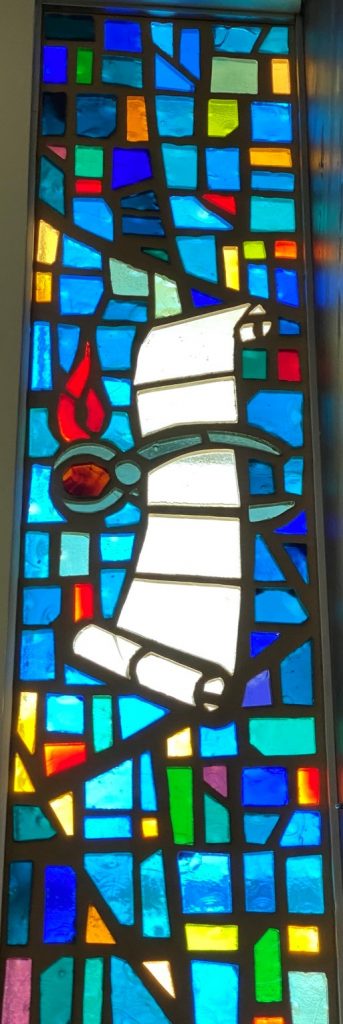
Window #5 Top 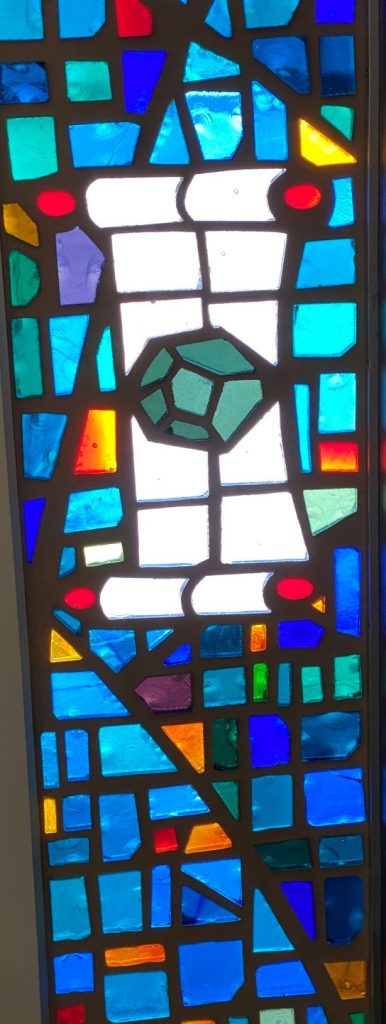
Window #5 Bottom
Window #5 – TOP ISAIAH Isaiah 6:6-7: The greatest of the prophets, Isaiah is symbolized by a scroll and tongs bearing a live coal of fire with which his lips were purged (6:6-7). The coal of fire is a symbol of prophetic powers and of the burning truth which can never be extinguished; it also symbolizes the ability of the one whom it touches to proclaim that truth in word and deed.
Window #5 – BOTTOM JEREMIAH Jeremiah 51:60, 63-64: The scroll and stone are part of the prophet’s oracle against Babylon. The scroll represents the book of prophecy which he spoke, and the stone was tied to the scroll was read. They were thrown into the Euphrates River. “Thus shall Babylon sink, to rise no more, because of the evil that I am bringing upon her.”

Window #6 Top 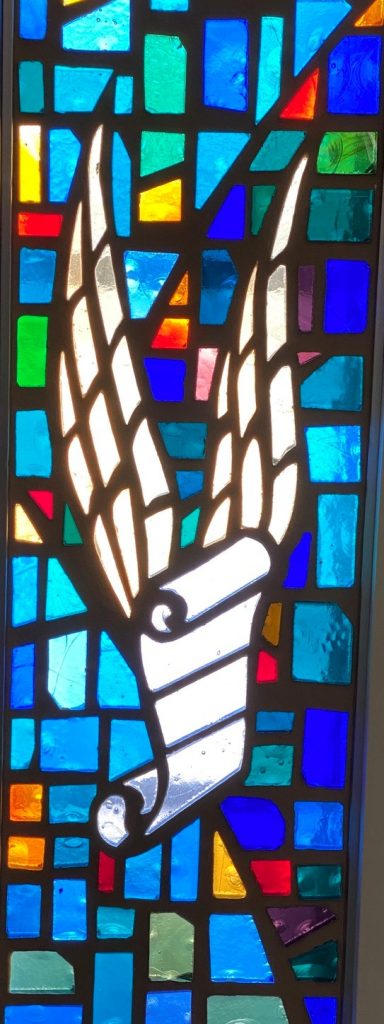
Window #6 Bottom
Window #6 – TOP AMOS Amos 7:14-15: Representing the minor prophets, Amos is symbolized by a shepherd’s staff. He was a shepherd by trade and was the first of the writing prophets.
Window #6 – BOTTOM ZECHARIAH Zechariah 5:1-3: The winged scroll or flying scroll symbolizes a vision of the prophet in which he sees an immense scroll on which is inscribed the names and crimes of evildoers and which is flying over the land of Palestine (Chapter 5). It will reveal their evil and shower the curse of God upon them. This purging of the land of sin is necessary before the coming of the age of the Messiah.
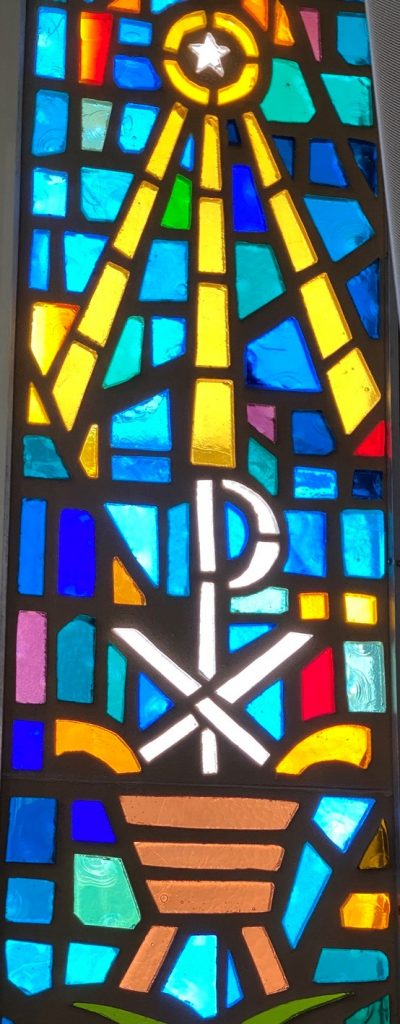
Window #7 Top 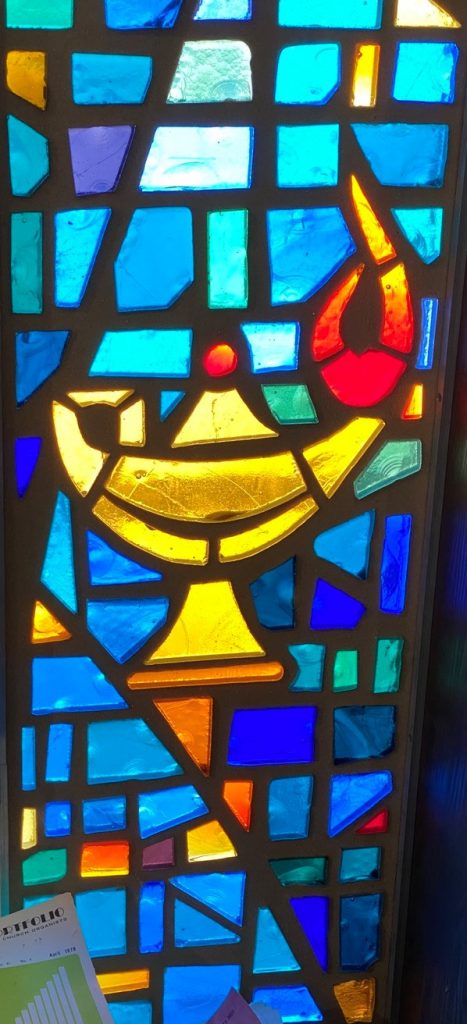
Window #7 Bottom
Window #7 – TOP THE NATIVITY Matthew 2:1-2, 9-10: The star is a symbol of God’s guidance or blessing. The star of Bethlehem led the Magi from the East to the manger. The symbol of Christ that has been in use for 1600 years is the Greek letters Chi Rho (X P) superimposed over each other to form a monogram. The two letters are the first two letters of Christ’s name in Greek and are found on walls, coins, and pottery of the early Christian era.
Window #7 – BOTTOM CHRIST IN THE TEMPLE Luke 2:41-43, 45-47, 49: The lamp, when lighted was a symbol of intelligence and learning. Today it stands for wisdom and knowledge which Christ showed when he astounded the teachers in the temple once when he was twelve years old (Luke 2:46-47).
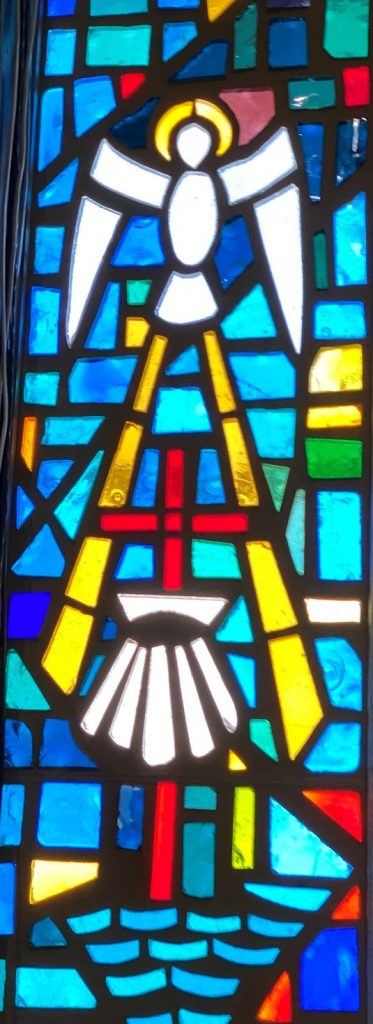
Window #8 Top 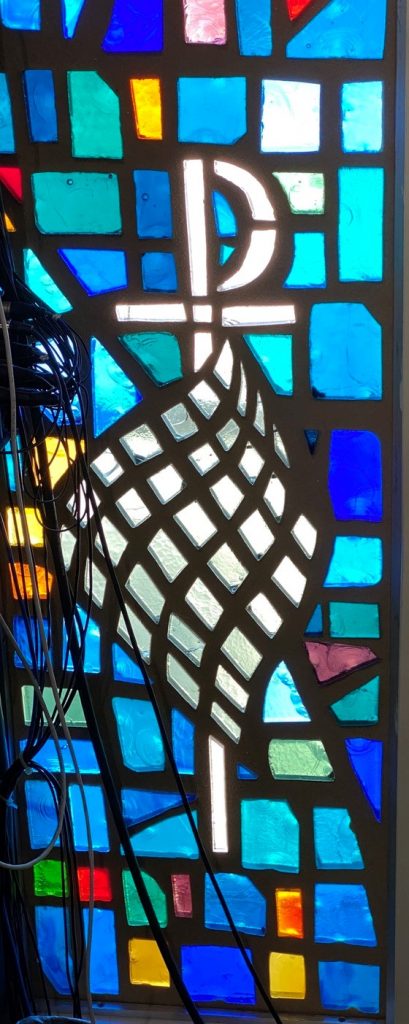
Window #8 Bottom
Window #8 – TOP BAPTISM Luke 3:21-22: The scallop shell is a symbol of baptism, especially the baptism of Jesus. The shape of the shell was handy as a spoon or cup to dip up the water. Shells were plentiful on the Galician shores of Spain where tradition records the Apostle James baptized many early Christians. The cross is a symbol of Christ and the Christian. The dove is a symbol of the Holy Spirit. When Jesus was baptized by John in the river Jordan, the Spirit descended on him like a dove.
Window #8 – BOTTOM CHOOSING THE DISCIPLES Matthew 4:18-20: The fish net with twelve small crosses symbolizes the calling of the disciples. When Jesus called Simon Peter and Andrew, they were fishing with their nets. Jesus said: “Follow me, and I will make you fishers of men.”
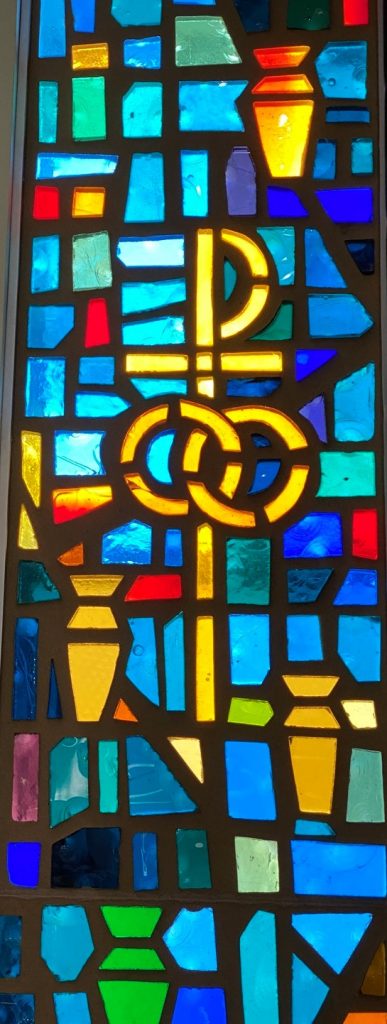
Window #9 Top 
Window #9 Bottom
Window #9 – TOP MIRACLE AT CANA John 2:1-12: The first miracle of Jesus was to change water into wine at a wedding in Cana. The wedding feast is symbolized by a group of water jars with a pair of interlocking rings. The Greek letters Chi Rho (X P) represent the presence of Christ.
Window #9 – BOTTOM FEEDING THE MULTITUDES John 6:1-13: Two fish and five loaves recall the miracle of feeding 5,000 as Jesus used the lunch of a young man. The Chi Rho (X P) represents Christ.
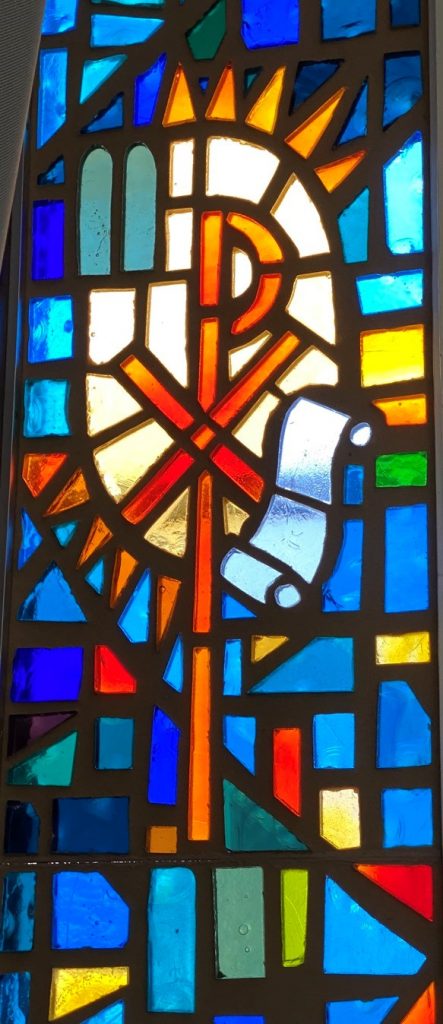
Window #10 Top 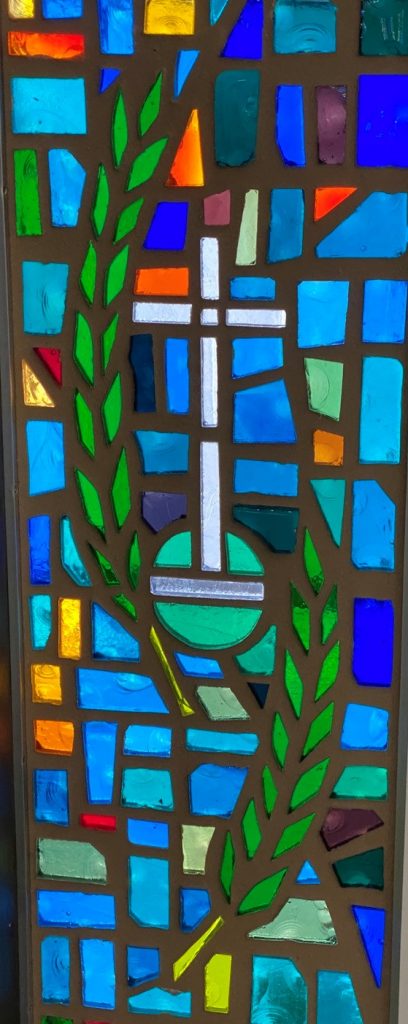
Window #10 Bottom
Window #10 – TOP TRANSFIGURATION Luke 9:28-36: This is represented with a Chi Rho (X P) symbol for Christ in the center of stone tablets on the left to represent Moses and the law and a scroll on the right to represent Elijah and prophecy.
Window #10 – BOTTOM TRIUMPHAL ENTRY Matthew 21:1-9: Jesus’ entry into Jerusalem on Palm Sunday is illustrated by a wreath of palm branches around a cross triumph. The cross and orb represents the spread of Christianity throughout the world. He cross refers to Jesus and the orb represents the globe or world.

Window #11 Top 
Window #11 Bottom
Window #11 – TOP LAST SUPPER Mark 14:22-26: The chalice surrounded by twelve crosses symbolize the Eucharist. Christ, the host, represented by the Chi Rho (X P), rises out of it.
Window #11 – BOTTOM GETHSEMANE Luke 22:39-46: A chalice with a pointed cross signifying the Lord’s agony, represents Jesus’ struggle in the Garden. “Father, if Thou be willing, remove this cup from me.”

Window #12 Top 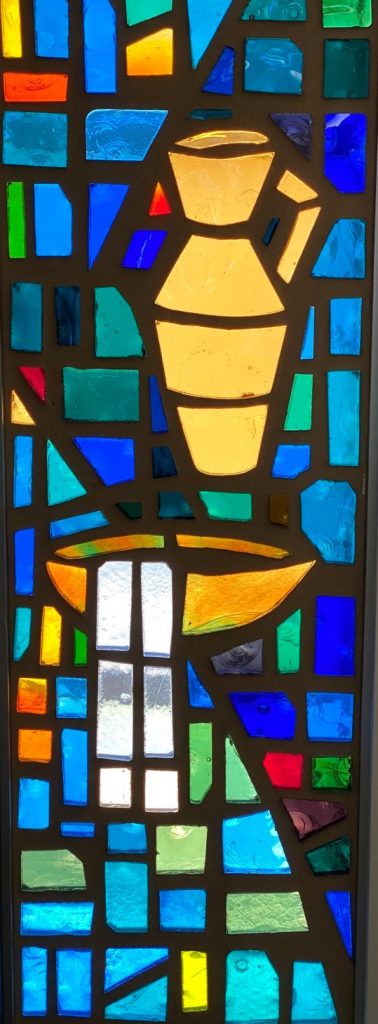
Window #12 Bottom
Window #12 – TOP BETRAYAL Luke 22:47-54: The symbol of Judas’ betrayal is a money bag surrounded by thirty pieces of silver.
Window #12 – BOTTOM PILATE Matthew 27:24-25: A pitcher, basin, and towel represent Pilate who washed his hands of the mob’s desire to crucify Jesus.

Window #13 Top 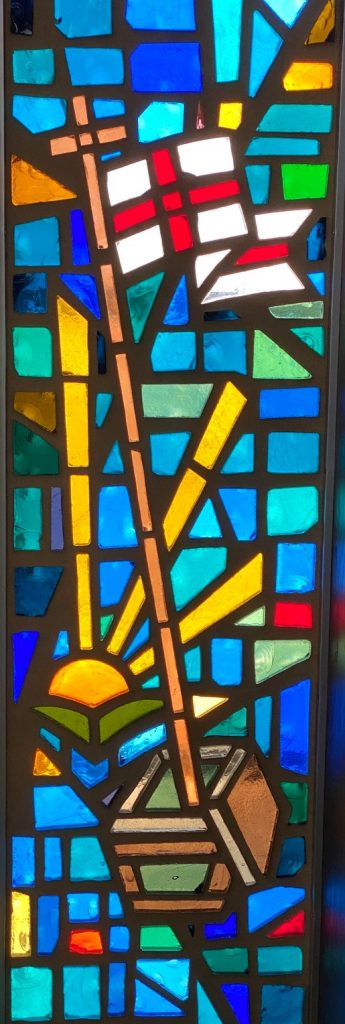
Window #13 Bottom
Window #13 – TOP CRUCIFIXION Matthew 27:31-38: Three crosses, the center one larger with a scroll at the top, and lightening striking it, symbolizes the crucifixion. On the scroll was written, “This is Jesus the King of the Jews.”
Window #13 – BOTTOM RESURRECTION John 20:11-18: A rising sun, an empty cross rising out of an empty burial vault, and a banner of victory represents the miracle of resurrection.

Window #14 Top 
Window #14 Bottom
Window #14 – TOP ASCENSION MARK 16:19 Luke 24:50-51 Acts 1:7-11 II Kings 2:11: The fiery chariot that took Elijah to heaven is used to represent Jesus’ ascension.
Window #14 – BOTTOM PENTECOST Acts 2:1-3: The birth of the Church is represented by the descending dove, the symbol of the Holy Spirit who descended on the disciples, and by seven flames of fire which symbolized the seven gifts of the Spirit – Wisdom, Understanding, Counsel, Might, Knowledge, Piety, and Fear of the Lord (Rev. 5:12). The tri-radiant nimbus around the dove’s head is the only true symbol of the Holy Spirit. It is a circle with three rays enclosed. For all who are referred to as saints, the circle or nimbus, is around the head, but without the three rays.

Window #15 Top 
Window #15 Bottom
Window #15 – TOP PETER Matthew 16:17-19: The leading apostle from Pentecost to the Council of Jerusalem in 50 A.D., Peter was crucified in Rome on a cross with his head down, according to tradition, because he felt unworthy to die the same way as his lord. His symbol is crossed keys, referring to Matthew 16:19, “I will give to you the keys to the kingdom of heaven.”
Window #15 – BOTTOM PAUL Ephesians 6:13-17: The apostle to the Gentiles is symbolized by an open Bible representing the message of the Church and a sword (“Sword of the Spirit”) which refers to his mission of spreading the good news throughout every land.

Window #16 Top 
Window #16 Bottom
Window #16 – TOP KING OF KINGS Revelation 1:8: Jesus Christ as triumphant King is symbolized with a crown and scepter with the first and last letter of the Greek alphabet, Alpha and Omega – “I am the Alpha and the Omega, the beginning and the ending…”
Window #16 – BOTTOM TRIUMPH OF THE GOSPEL Revelation 21:1-7: The symbol of the cross and the orb represents the spreading of Christianity throughout the world. The cross refers to Jesus and the orb represents the globe or world. The band around the world indicates the triumph of the Gospel over the world.

